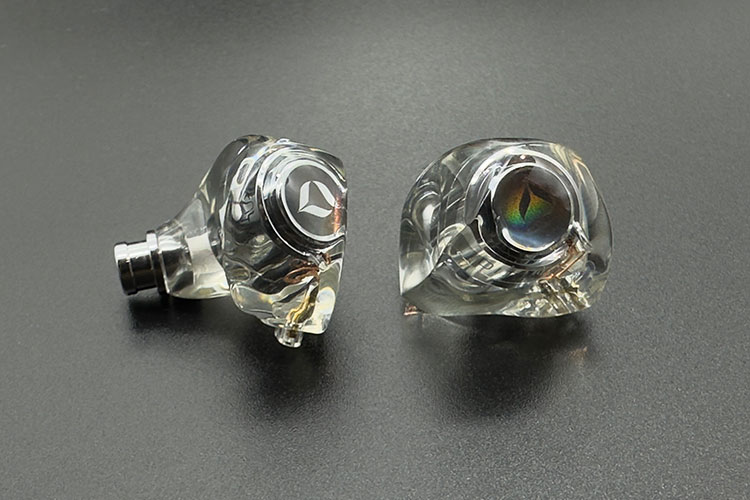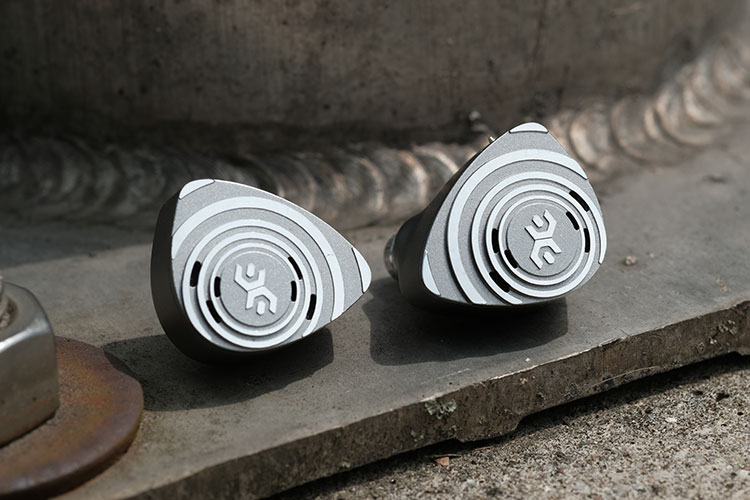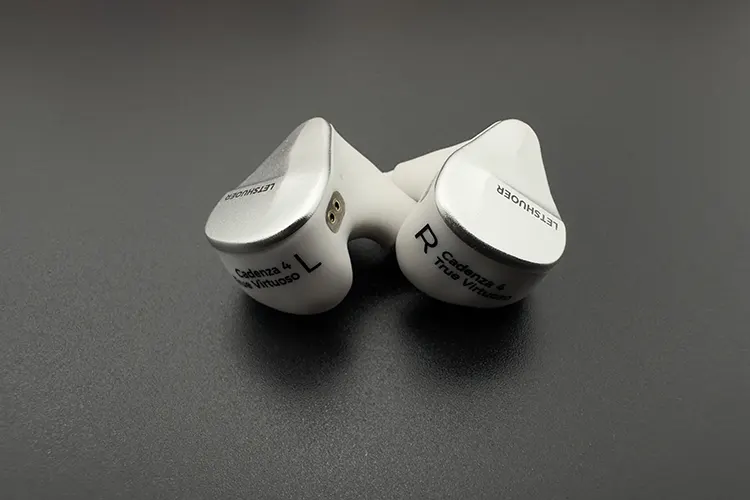Synergy
Project M has an impedance of 32Ω @1kHz and a sensitivity rating of 107 dB/Vrms. It can be easily driven by sources with less power such as dongles and smartphones. However, the IEM can take a good amount of power.
Even my Lotoo Paw Gold Touch takes nearly a few more volume clicks than usual IEMs. With better power, the IEM opens up quite well, and there is a noticeable expansion in the stage width.
On some occasions, I tested Project M with the EarMen Angel, a source with decent power, and observed the Angel opening up the IEM quite well and adding to the dynamics.
The bass response, in particular, gains more impact and authority. Interestingly, despite Earmen Angel’s profile as a neutral to slightly bright source, the combination with Project M is highly enjoyable.
There was no noticeable increase in brightness in the overall sound, which is a pleasant surprise. Additionally, even with more power, there is no hiss or waterfall in the background.
Select Comparisons
Elysian Acoustic Labs PILGRIM
Technical
PILGRIM is a new hybrid using a single 9.2mm dynamic and triple BA driver implementation.
The custom 9.2mm dynamic driver within the PILGRIM features Liquid Silicone Rubber (LSR) technology and a Magnesium-aluminum alloy diaphragm.
For the mids and the highs, Elysian has equipped the PILGRIM with a custom-tuned Sonion 2300 BA for a refined, realistic presentation and a dual-tweeter E50 with a custom 3-way crossover threading all 4 drivers together.
Design
The shell of the PILGRIM is crafted from high-quality aluminum while the bores are made from 304 stainless steel, renowned for its corrosion resistance. The shells are lightweight and quite durable.
The PILGRIM’s silver housings feature knoll-inspired ridges that embellish the faceplate, drawing attention with their unique design. To add to the appearance is a combination of reflective and matte finishes, complemented by six vents surrounding a prominent central logo.
When it comes to appearance and design, both IEMs are excellently crafted, making it difficult to determine which is superior. Each boasts a high-quality build and similar weight.
The PILGRIM’s cable offers a choice of either 3.5mm or 4.4mm termination at the time of purchase, whereas the Project M features a modular cable. Additionally, Project M includes superior accessories compared to the PILGRIM.
Performance
Regarding bass performance, the PILGRIM offers less quantity compared to the Project M, but the bass on the Project M is more textured and has a fuller mid-bass body.
Although the difference in quantity isn’t substantial, the PILGRIM boasts greater sub-bass depth. Overall, the bass impact is more pronounced on the Project M.
In the midrange, Project M stands out with a more forward, cleaner, and transparent presentation. It delivers more energy in the midrange, with female vocals sounding especially natural and organic. The lower mids also carry a bit more weight on Project M.
In the treble region, Project M takes the lead with greater energy and extension in the upper frequencies, though it can occasionally be sharp. The PILGRIM’s treble is commendable, with decent energy and extension, but it slightly lags behind Project M.
Both IEMs perform admirably in terms of technical aspects, with excellent detail retrieval on both. The Project M, however, offers a superior sense of stage spaciousness.
Additionally, it scales significantly with higher-quality sources, delivering markedly improved performance when paired with powerful equipment.
LETSHUOER Cadenza4
Technical
The Cadenza4 is a hybrid universal in-ear monitor using a 10mm dual-chambered beryllium-coated dynamic driver and 3 BA drivers. With Cadenza4, you get a mix of BA drivers, 1 from Sonion and 2 from Knowles.
The Cadenza4 has an impedance of 15Ω @1kHz and a sensitivity rating of 102 dB/Vrms so it is quite an easy IEM to drive. Compared to Project M, the Cadenza4 is easier to drive and does not demand a lot of power to open up.
Design
The shells of the Cadenza4 are built in 3D-printed resin with a standard-sized nozzle extension. The faceplate is built in CNC-machined aluminum alloy and is colored shiny silver.
The fit on the Cadenza4 is as comfortable as with the Project M; however, the Project M does stick out more in my ears. In terms of design, Project M can be considered an upgrade to the Cadenza4.
Cadezna4 connects with a 0.78mm 2-pin connector. As with Project M, one gets a modular cable with multiple connectivity options of 4.4mm and 3.5mm and an extra 2.5mm plug.
Project M offers a notably enhanced and more sophisticated presentation, evident in its packaging.
The quality of accessories included with Project M is far superior, leaving LETSHUOER trailing behind. The box is more neatly arranged, making the unboxing experience of Project M much more enjoyable compared to the Cadenza4.
Performance
The sound profile of both of these IEMs is near-neutral with a slight warmth in the midrange. However, Project M has an energetic upper mids and treble region.
Project M can be seen as an overall upgrade from the Cadenza4. For someone seeking an upgrade from the Cadenza4 while maintaining a similar sound signature, the Project M is the ideal choice.
The bass on both of these IEMs is just north of neutral. Both of them have a sub-bass focus and the mid-bass lacks the necessary impact and punch. Project M is better in terms of both quantity and quality. The bass on Project M has better layering and texture.
The midrange on both of these IEMs has a focus on clarity and detailing. With Project M, the details are more pronounced. The midrange on Project M has more energy than the relaxed midrange on the Cadenza4. The upper mids have safer tuning on the Cadenza4. It does not get shouty.
In terms of treble, Cadenza4 has a more controlled and relaxed treble, which is ideal for treble-sensitive people. The upper treble is rolled off and has a less detailed presentation. The overall treble lacks a bit when it comes to minute details.
In terms of technical aspects, Project M is ahead of Cadenza4. The stage has more width on Project M. There is a greater sense of spaciousness and openness in the sound on Project M. The Cadenza4 has weak imaging if compared to Project M.
Kinera Freya 2.0
Technical
The Kinera Freya 2.0 is a quad-driver hybrid universal IEM rated at 25 ohms impedance and 105 dB @1kHz mW SPL. The driver configuration is three Knowles drivers for the mids and highs and a custom 7mm dynamic driver for the lows with a 3 acoustic tube 3+1 crossover tuning.
Freya 2.0 is easier to drive and is not as demanding as Project M. On a more powerful source, the Freya 2.0 can have static background hissing noise.
Design
The Freya 2.0 shells are made from high-quality resin and are hand-painted. The design and color scheme of both the IEM shells are quite different. The size of the Freya 2.0 is smaller and fits better than Project M. In terms of build quality, the shells of Project M feel more durable.
Similarly to Project M, the Freya 2.0 comes with a modular cable option offering both 4.4mm and 3.5mm termination options. The cable on Freya 2.0 is firmer in build.
Kinera delivers a visually appealing experience, showcased through its vibrant packaging and eye-catching shell designs.
In contrast, Project M opts for a simpler yet sophisticated color scheme. While both IEMs provide an excellent unboxing experience, I favor DITA’s overall approach.
Performance
The Freya 2.0 offers a sound profile that leans towards a more neutral tone. Its bass performance is subdued, with the sub-bass lacking significant impact and the mid-bass being somewhat underwhelming in terms of presence and quantity.
The bass on Project M has more quantity, both in the sub-bass and mid-bass. There is better layering and texture on the bass too.
In the midrange, the Freya 2.0 lacks clarity and resolution, resulting in a somewhat muddled sound that obscures finer details. The presentation feels hazy, preventing the midrange elements from standing out distinctly.
In the higher frequencies, the Freya 2.0 is deficient in airiness and sparkle. Its treble is noticeably darker compared to Project M, which offers a much more detailed and well-extended treble profile.
In terms of technical prowess, Project M is quite ahead of Freya 2.0. The sound on Project M is more open, and there is better detail retrieval too. On other fronts, such as imaging, layering, and instrument separation, Freya 2.0 is quite behind the more technically competent Project M.
My Verdict
DITA Audio’s debut hybrid IEM, Project M, marks an exciting milestone as their most affordable IEM yet. The company has excelled in design, tuning, and packaging, delivering an outstanding experience.
The inclusion of high-quality accessories further enhances its appeal, making it a standout contender in its price range.
In terms of sound, Project M delivers a neutral-bright sound profile, showcasing exceptional resolution and technical prowess. Those who prefer a near-neutral sound signature will find the IEM’s tuning highly satisfying.
Overall, Project M emerges as a commendable release from DITA Audio.
DITA Audio Project M Specifications
- Driver Configurations: 1 DD + 1 BA (PM1+ Dynamic Driver, 9.8mm x 1 + Knowles 33518 Driver x 1)
- Frequency Response: 20 Hz- 20 kHz
- Impedance: 32 Ohms
- Sensitivity: 107 dB/mW @ 1 kHz
- Cable: MOCCA cable (Made with Cardas Grade 1 Ultra-Pure Copper conductors)
- Includes 4.4mm balanced and 3.5mm single-ended connecting plugs





